In 2025, choosing the right headless eCommerce platform is key for businesses looking to create fast, flexible, and future-ready online stores. Unlike traditional systems, headless platforms decouple the frontend from the backend, allowing teams to build custom storefronts, boost performance, and integrate best-in-class tools across their stack.
Below, we explore some of the best headless eCommerce platforms to consider in 2025:
- Shopify (Hydrogen + Oxygen) – Great for Shopify users who want full design control
- BigCommerce – Flexible SaaS backend with powerful headless capabilities
- Adobe Commerce – Enterprise-grade solution with content personalization via AEM
- Salesforce Commerce Cloud – Robust API-first platform with deep CRM and marketing integrations
- Commercetools – MACH-certified platform for composable, API-first commerce
- Fabric – Modular, performance-focused stack for fast-growing retailers
- Saleor – Open-source, GraphQL-native headless platform for global brands
- Elastic Path – Composable architecture built for complex product catalogs
- Swell – Developer-friendly with built-in logic for subscriptions and bundles
- OroCommerce – Purpose-built for B2B headless commerce
- Headless CMS options – Strapi, Contentful, DatoCMS, and Directus for content delivery
Each platform brings a unique balance of flexibility, scalability, and integration support to match different business models and development teams.
Understanding Headless eCommerce in 2025
What is a headless eCommerce platform?
A headless eCommerce platform separates the frontend (what customers interact with) from the backend (where product, order, and customer data live). These two layers communicate via APIs, giving developers full flexibility to create custom storefronts, mobile apps, kiosks, or any digital touchpoint—all powered by a centralized backend.
This approach contrasts with traditional monolithic platforms, where frontend and backend are tightly coupled, making changes slower and limiting design freedom. In a headless model, businesses can mix and match tools like frontend frameworks (React, Vue, Next.js) and backend services (Shopify, Magento, Saleor), often paired with a headless CMS like Strapi or Contentful.
Here's headless vs traditional eCommerce at a glance:
Feature | Traditional eCommerce | Headless eCommerce |
Frontend and backend | Tightly coupled | Fully decoupled via APIs |
Design flexibility | Limited by platform themes | Full control with custom code |
Performance & speed | Dependent on theme & plugins | Optimized via custom frontend |
Tech stack freedom | Fixed / vendor-specific | Framework-agnostic (React, etc.) |
Omnichannel support | Limited | Built for multi-channel |
Need a visual? Here’s a quick side-by-side comparison:

This architecture is what enables brands to innovate faster, personalize experiences, and integrate with best-in-class tools across CMS, PIM, and marketing stacks—something we’ll explore more in the platform breakdown below.
Why are more businesses switching to headless in 2025?
The shift toward headless architecture is accelerating in 2025 as brands look to future-proof their commerce infrastructure. Beyond performance and flexibility, headless also offers improved security, better scalability, and greater freedom in tech stack choices.
Key advantages of a headless eCommerce platform include:
- Faster performance and Core Web Vitals compliance
- Customizable, conversion-optimized storefronts
- Omnichannel selling across web, mobile, PWA, and in-store
- Stronger security, as frontend and backend are decoupled, limiting the attack surface
- Seamless integration with CMSs, PIMs, ERPs, and third-party tools
- Better workflows for developers and content teams
- Composable architecture, allowing businesses to build only what they need
So, who is headless right for? Headless is ideal for:
- DTC brands needing high-performance, content-rich storefronts
- B2B businesses with complex pricing, catalogs, or workflows
- Global companies that need multi-language, multi-region flexibility
- Tech-savvy teams with in-house developers or agency partners
- Companies prioritizing API-first integrations and long-term scalability
Brands like ILIA Beauty, Burrow, Black Diamond, and White Stuff already use headless architecture to scale globally, launch faster, and create standout digital experiences.
So which platform is right for your business?
Below is LitExtension‘s curated list of the 10 best headless eCommerce platforms for 2025, each offering a unique balance of flexibility, speed, and scalability—tailored to different team sizes, tech stacks, and growth goals.
10 Best Headless eCommerce Platforms 2025
1. Shopify (Hydrogen + Oxygen)
Best for: Shopify merchants and fast-scaling D2C brands looking for frontend freedom without giving up Shopify’s backend power.
Shopify’s headless offering revolves around Hydrogen, a React-based framework for building custom storefronts, and Oxygen, its globally distributed hosting platform. Together, they let merchants break free from theme limitations while keeping Shopify’s backend for products, checkout, orders, and integrations.

Brands like Babylist, Ruggable, and Figs have used headless eCommerce Shopify in headless setups to create fast, content-rich, and performance-optimized storefronts.
Can I build a fully custom storefront while still using Shopify as my backend?
Yes. Hydrogen enables teams to create React-based storefronts with complete design control, while Shopify continues to manage core functions like inventory, checkout, and payments. This setup is ideal for merchants who need more flexibility than what Liquid themes allow.
How developer-friendly is Shopify’s headless setup?
Shopify provides prebuilt Hydrogen templates, built-in tooling, and tight integration with Oxygen hosting, making it relatively quick to set up. Developers can also connect CMSs like Contentful or Sanity, or integrate ERP and PIM systems via Shopify’s Storefront API. The platform supports custom development for web, mobile, and PWA interfaces.
Pros:
- Full design and UX freedom
- Native tools for fast performance and deployment
- Easy to integrate with modern stacks and enterprise systems
- Supported by Shopify’s scalability and ecosystem
Cons:
- Requires React/front-end development skills
- Still maturing as a headless solution (compared to open-source stacks)
- Tied to Shopify’s backend model (not backend-agnostic)
2. BigCommerce (API-driven & flexible)
Best for: Mid-sized to enterprise merchants that want headless flexibility without the overhead of managing backend infrastructure.
BigCommerce delivers a robust headless commerce offering through an API-first SaaS platform. It allows businesses to build custom storefronts using frameworks like React, Next.js, Nuxt, or Gatsby—while keeping eCommerce operations like catalog, checkout, and promotions managed through a secure, scalable backend.
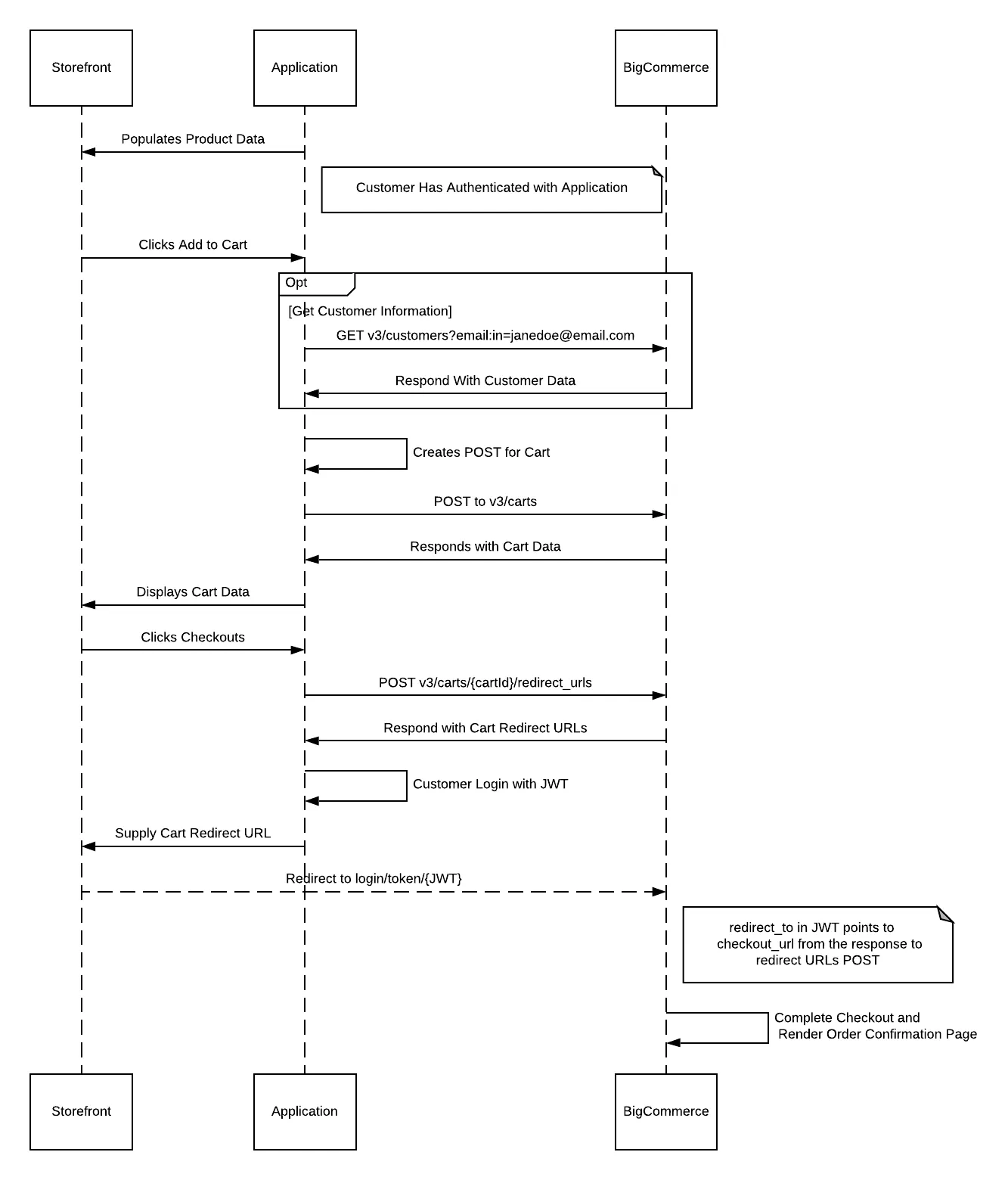
Brands like Discount Electronics, Black Diamond, and Gorewear have adopted BigCommerce for headless builds to improve performance, enhance content delivery, and streamline integration across systems.
Can I build a fully custom storefront while using BigCommerce’s backend and APIs?
Yes. BigCommerce provides both REST and GraphQL APIs, enabling developers to build fast, flexible storefronts using their preferred frontend stack. You retain full control over design and UX while leveraging BigCommerce’s backend for reliable commerce logic.
Does BigCommerce integrate easily with headless CMSs and digital experience platforms (DXPs)?
Absolutely. BigCommerce works out-of-the-box with platforms like Contentful, WordPress, Prismic, and Bloomreach, allowing teams to unify content and commerce workflows. It’s ideal for businesses that want to deliver experience-led commerce without managing backend infrastructure.
Pros:
- Headless flexibility with no backend maintenance
- Built-in integrations reduce time-to-launch
- Scalable for B2C, B2B, and multi-brand use cases
- Ideal for teams that want developer freedom without replatforming entirely
Cons:
- Not open-source; locked into BigCommerce’s ecosystem
- Backend logic customization is limited by SaaS constraints
- May require frontend developers for full headless implementation
3. Magento / Adobe Commerce (with Edge Delivery Services)
Best for: Enterprise brands that want a customizable, performance-driven headless setup built on Adobe’s robust commerce and content ecosystem.
Adobe Commerce (formerly Magento Commerce) offers a headless architecture through its Edge Delivery Services, GraphQL APIs, and integration with Adobe’s broader Experience Cloud. It supports highly tailored storefronts and connects deeply with enterprise-grade tools like Adobe Experience Manager (AEM), enabling unified content + commerce delivery at scale.

Headless commerce examples like Missoma and Topps Tiles demonstrate how Adobe’s stack helps brands combine content agility with enterprise-level performance to drive growth.
Can I build a high-performing headless storefront with Adobe Commerce?
Yes. Adobe Commerce supports headless via GraphQL APIs, App Builder, and its new Edge Delivery Services — a system optimized for blazing-fast storefront rendering and SEO performance. It includes intelligent caching, component-based rendering, and seamless content + product delivery.
What tools does Adobe offer for headless content and experience management?
Adobe provides a robust ecosystem: AEM for content personalization, AI-powered content creation, dynamic blocks for contextual content, and easy authoring with drag-and-drop tools. This empowers marketers and dev teams to collaborate efficiently without needing deep technical skills for every update.
Pros:
- Enterprise-grade scalability and flexibility
- Full integration with Adobe Experience Cloud
- Optimized frontend performance and SEO readiness
- Strong content and experimentation tools (A/B testing, personalization)
Cons:
- Complex setup; best suited for teams with enterprise resources
- High total cost of ownership (licensing, implementation, Adobe stack)
- Learning curve if not already within Adobe ecosystem
4. Salesforce Commerce Cloud (enterprise-grade)
Best for: Enterprise businesses that need a flexible, scalable headless platform integrated with Salesforce's broader CRM and marketing tools.
Salesforce Commerce Cloud offers a robust headless architecture through its Composable Storefront and Commerce APIs, enabling enterprise brands to create custom digital experiences across channels. Paired with Salesforce’s trusted infrastructure and extensive ecosystem, it allows teams to build, scale, and optimize storefronts while connecting deeply with customer data and marketing workflows.
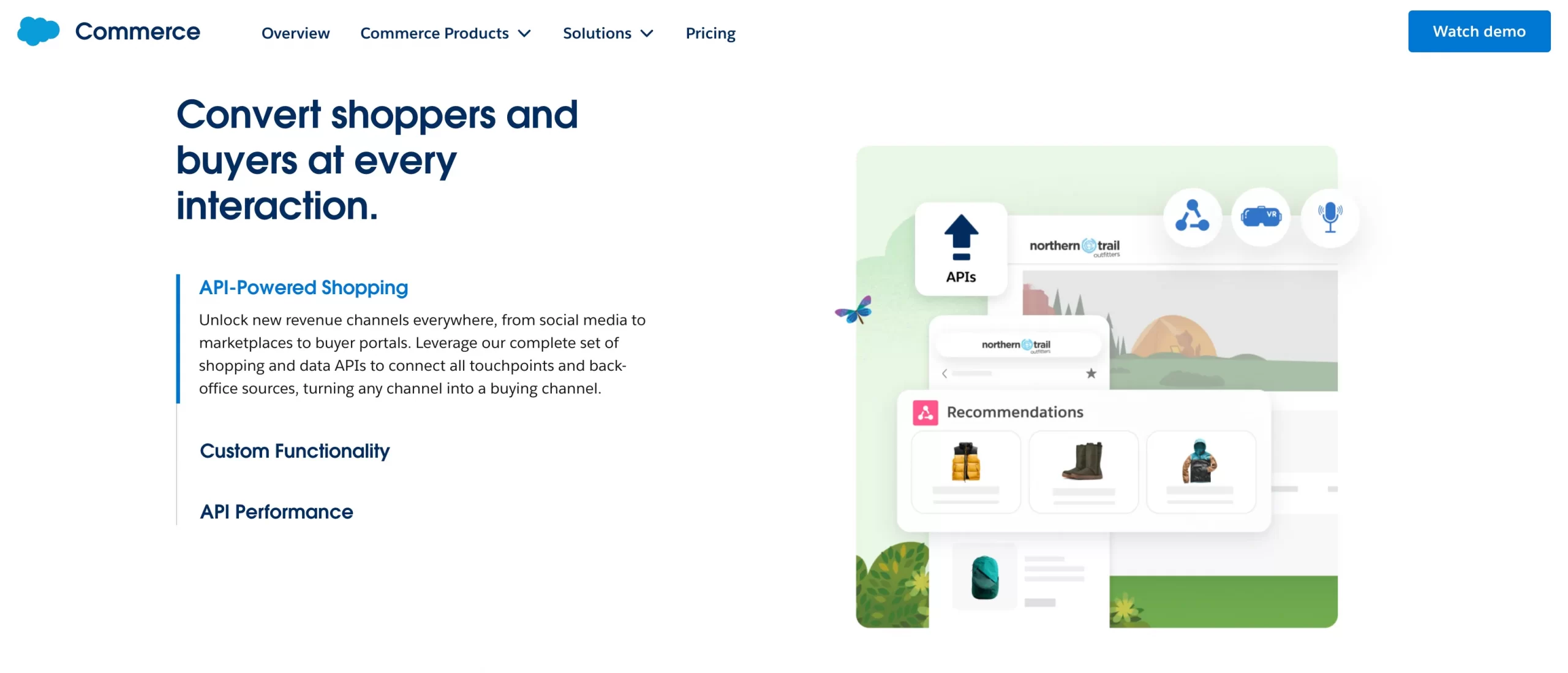
Leading companies across retail and B2B use Salesforce headless commerce to deliver personalized, omnichannel experiences with speed and reliability.
Can I build a custom frontend while still leveraging Salesforce’s backend for commerce operations?
Yes. Salesforce enables headless storefronts via its Composable Storefront, a flexible front-end framework that works with your preferred technologies. You can decouple the UI, use modern frameworks like React, and pull data from Commerce Cloud APIs for checkout, pricing, inventory, and promotions.
How does Salesforce help enterprise teams scale and personalize headless commerce?
Salesforce integrates seamlessly with its full ecosystem—Customer 360, Marketing Cloud, and Service Cloud—giving brands real-time access to customer data, AI-driven personalization, and omnichannel insights. Teams can also manage multi-region deployments, maintain uptime at scale, and integrate with partner tools like Algolia, Akeneo, and Contentful.
Pros:
- Full-stack flexibility with enterprise-grade reliability
- Deep integration with Salesforce’s ecosystem for marketing and customer data
- Headless-first tools for scaling multi-channel experiences
- Large partner and developer support network
Cons:
- Requires significant development resources for frontend setup
- Higher licensing and implementation costs
- Best suited for businesses already using Salesforce products
5. Commercetools (MACH architecture leader)
Best for: Large enterprises and global brands building highly customized, composable commerce architectures with full development freedom.
Commercetools is a headless, API-first commerce platform built on MACH architecture (Microservices, API-first, Cloud-native, Headless). It enables enterprises to decouple every layer of their commerce stack—giving complete freedom over frontend, backend services, integrations, and deployment.
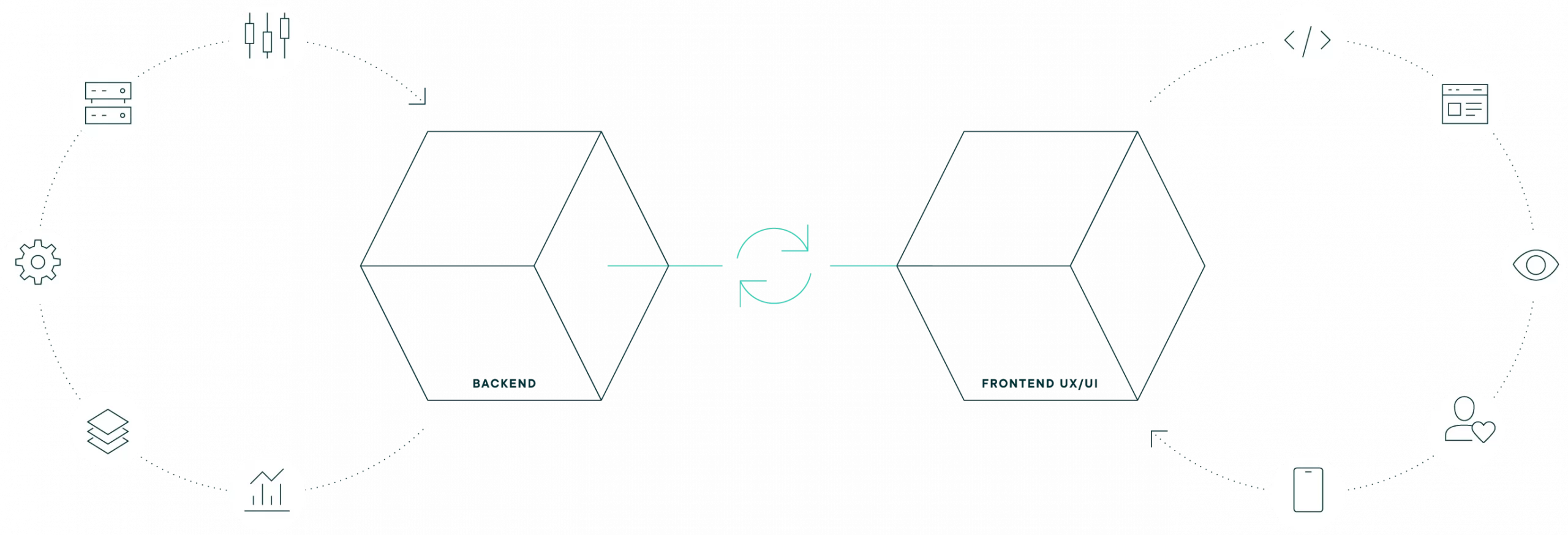
Brands like Audi, Bang & Olufsen, and Express rely on Commercetools to power agile, scalable digital commerce experiences worldwide.
What makes Commercetools different from other headless platforms?
Commercetools isn’t just headless—it’s fully composable. You can plug in or replace any service (cart, checkout, catalog, etc.) via APIs. It’s microservice-based, so each component scales independently. This makes it ideal for businesses that want to build tailored commerce stacks using best-in-class services, not one monolithic suite.
How does Commercetools help enterprise teams stay agile and competitive?
Its architecture allows for continuous deployment and zero-downtime releases, even during peak periods. You can roll out new features fast, localize global storefronts, or personalize promotions using external CMS, search, and personalization tools—all without vendor lock-in or system slowdowns.
Pros:
- Complete flexibility to design custom commerce architectures
- Built for scale, speed, and global expansion
- Enterprise-proven for high-demand environments
- MACH-compliant for long-term tech stack freedom
Cons:
- Requires a mature dev team or agency to implement and maintain
- Higher learning curve due to flexibility and modularity
- Cost and complexity not ideal for mid-market or simple stores
6. Fabric (modular and fast-growing)
Best for: Fast-growing digital retailers and B2B businesses looking for modular, API-first headless commerce without the complexity of open-source platforms.
Fabric is a modern headless eCommerce platform built around a suite of modular APIs for orders, products, inventory, cart, shipping, and promotions. It’s designed for performance, extensibility, and fast time-to-market. With over 300 APIs and a fully composable architecture, Fabric enables brands to create scalable, tailored commerce solutions without starting from scratch.
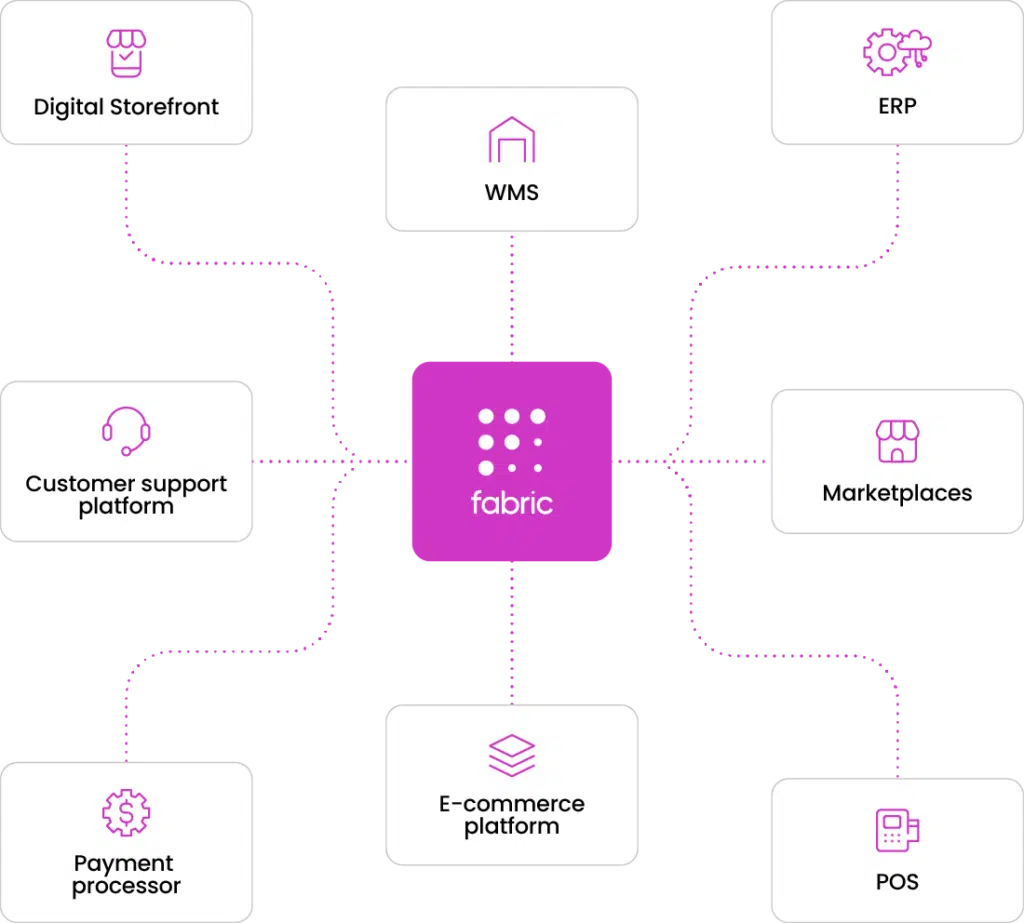
Brands like McDonald’s use Fabric to streamline operations and deliver consistent, high-speed digital experiences across multiple touchpoints.
How flexible is Fabric when building custom headless storefronts?
Very. Fabric provides granular APIs across all core commerce functions, so you can plug in only the services you need. Its architecture supports custom frontend development using any framework, enabling you to build pixel-perfect storefronts while maintaining backend flexibility and speed.
What makes Fabric ideal for fast-moving businesses?
Fabric focuses on quick deployment and scalability. With low-latency APIs, prebuilt logic for essential commerce operations, and real-time webhooks, development cycles are short and performance is high. It’s also compliant with enterprise security standards, making it a strong fit for businesses with strict operational requirements.
Pros:
- API-first and modular by default
- Quick to deploy, with built-in commerce logic
- Enterprise-grade security and global CDN infrastructure
- Easy to extend or pair with existing tools
Cons:
- Requires a developer team to configure and scale
- Limited community resources compared to open-source alternatives
7. Saleor (open-source GraphQL-based)
Best for: Developer-led teams and global brands that want full control of their tech stack with a fast, composable, open-source headless platform.
Saleor is a GraphQL-native, open-source headless commerce platform built with Python and React. It’s designed for speed, scalability, and developer freedom, offering a composable backend and customizable storefronts. From multinational retailers to high-growth DTC brands, Saleor powers performance-driven commerce with a code-first mindset.
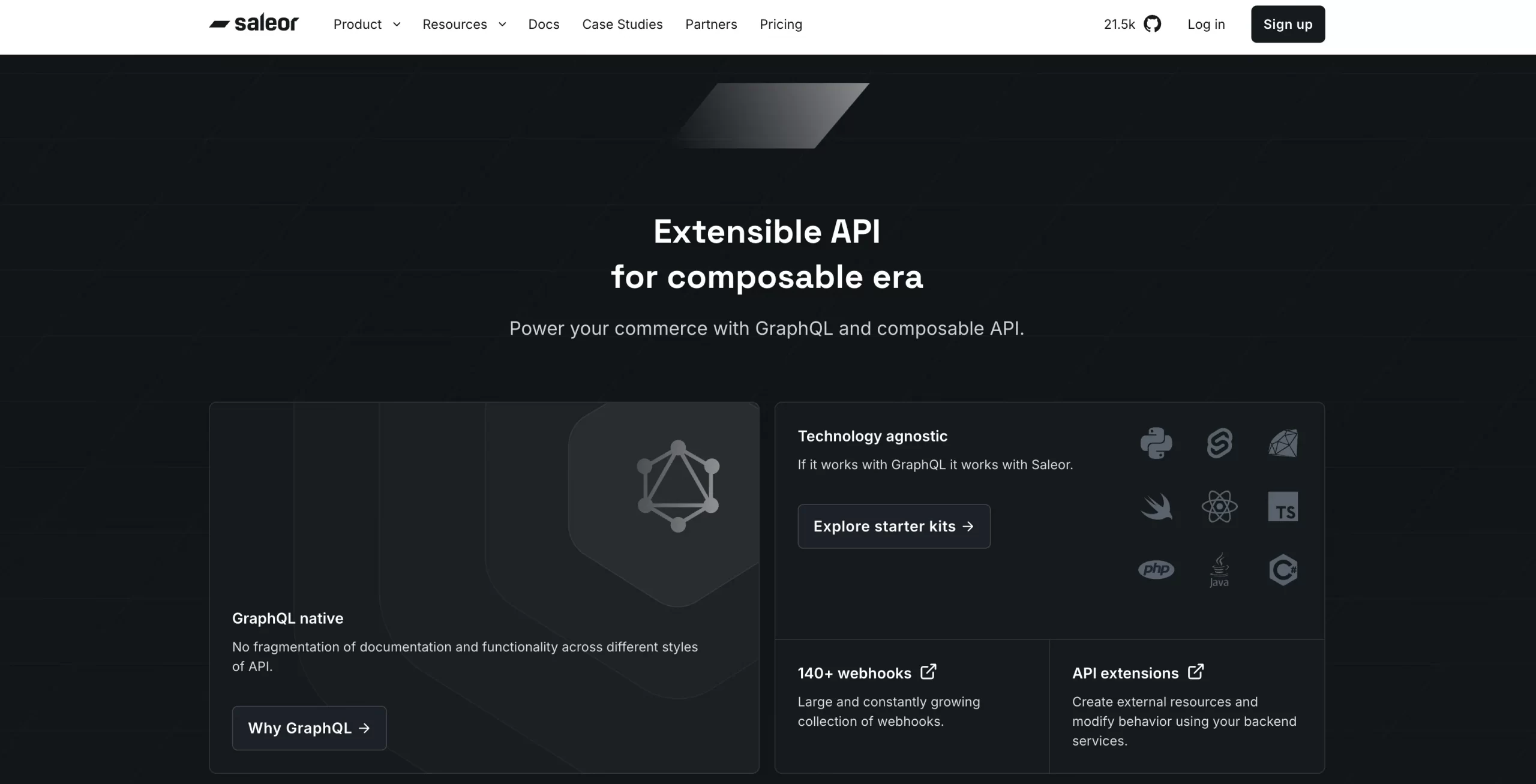
Global brands like LUSH, Breitling, and Unicef trust Saleor to support highly customized, high-volume storefronts with advanced content modeling and internationalization.
How does Saleor support composable commerce architecture?
Saleor is built for the composable era. It offers 100% API coverage using GraphQL, supports custom schemas, and allows developers to replace or extend any service. Its modular design makes it easy to integrate best-of-breed tools—CMSs, payment providers, personalization engines—without being locked into a rigid suite.
What makes Saleor ideal for global and fast-scaling brands?
With native support for multi-language, multi-currency, and multi-channel commerce, Saleor is ready for international growth. Its extensible checkout, content model, and partner app ecosystem let you customize key business processes without sacrificing speed or security.
Pros:
- True developer-first experience with complete flexibility
- Enterprise-ready while fully open source eCommerce platform
- Built-in support for complex global commerce
- Fast performance and modern developer tooling
Cons:
- Requires internal dev resources or partners for setup and scaling
- May be overwhelming for early-stage or non-technical teams
- No official SaaS offering unless using third-party Saleor Cloud
8. Elastic Path (API commerce engine)
Best for: Enterprises and fast-scaling brands that want to build fully composable commerce experiences using flexible APIs and pre-integrated components.
Elastic Path is a headless, API-first commerce platform designed for composable commerce. It enables brands to orchestrate flexible digital experiences using modular services, pre-composed solutions, and business-ready APIs. Elastic Path supports B2C, B2B, and marketplace models—letting you launch fast, integrate freely, and scale globally.
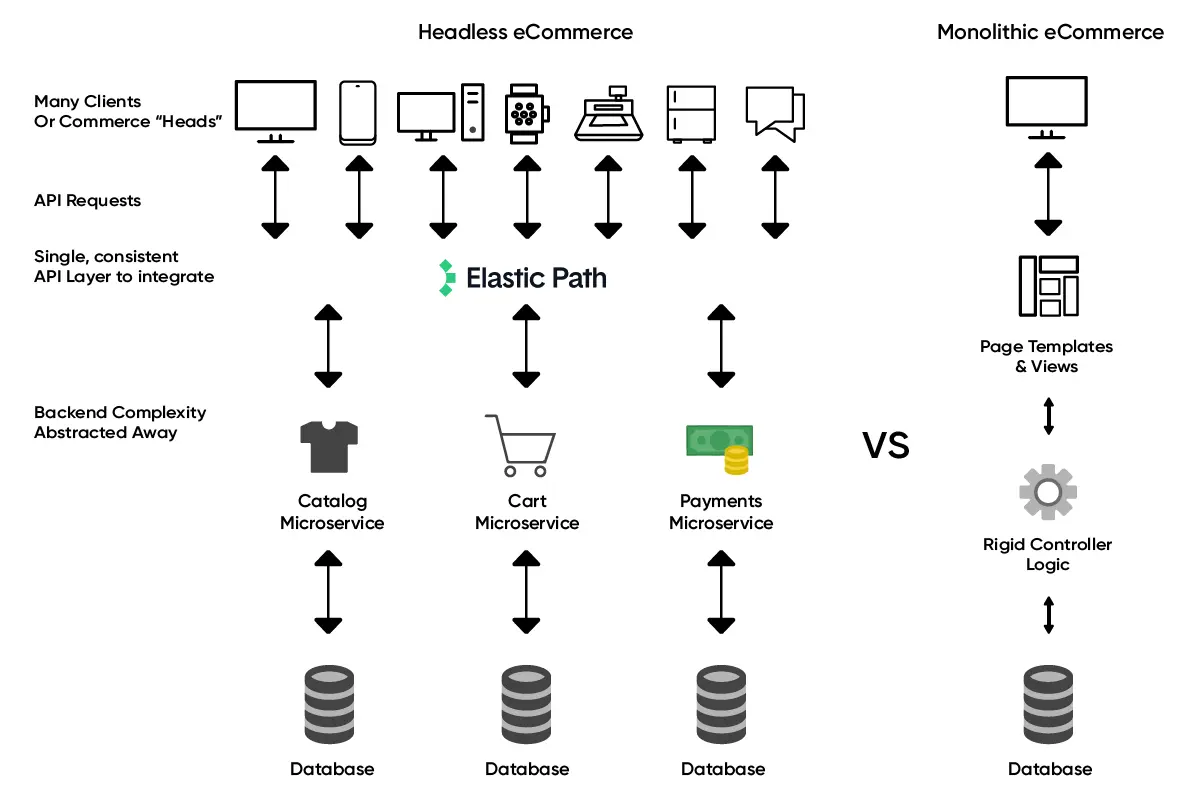
Enterprises like PAX Labs use Elastic Path to implement custom experiences without being held back by rigid, traditional commerce architectures.
How does Elastic Path support composable and headless commerce?
Elastic Path’s architecture is built entirely around composable services—including pricing, cart, checkout, orders, and catalog. These services are decoupled and accessible via APIs, allowing teams to integrate only what they need and plug in best-of-breed CMS, search, and personalization tools across touchpoints.
What makes Elastic Path suitable for high-growth or complex commerce operations?
With capabilities like Product Content Management, Experience Composer, and Price Books, Elastic Path gives brands deep control over merchandising and experience logic. It also provides pre-composed integrations to reduce launch time and simplifies orchestration across multiple frontends, geographies, or business models.
Pros:
- Built for flexibility and long-term scalability
- Modular services enable faster time-to-market
- Fits a wide range of use cases (B2C, B2B, marketplaces)
- Integrates easily with CMSs, DXP tools, and frontend stacks
Cons:
- Requires developer resources for full implementation
- Complex setup if you don’t use pre-composed solutions
- More suited to teams with experience in composable architecture
9. Swell (developer-friendly startup option)
Best for: Startups, fast-growing brands, and mid-market businesses looking for a modern, developer-friendly headless platform with built-in commerce logic and flexible APIs.
Swell is a headless commerce platform designed to give developers and merchants full customization capabilities without the complexity of legacy systems. It offers composable APIs, flexible product modeling, and a modern dashboard for managing stores at scale. Swell is ideal for teams that want to build custom storefronts and handle complex product configurations with ease.

As one of the most adaptable headless eCommerce platform examples, Swell is trusted by brands like Swingers to deliver fast, content-rich storefronts with developer-first control.
What makes Swell different from other headless eCommerce platforms?
Swell combines commerce-as-a-service flexibility with a prebuilt dashboard and logic for catalogs, carts, orders, and checkout. Developers can build using any frontend framework while relying on Swell’s native admin tools and APIs. It also handles advanced scenarios like product bundles, options, subscriptions, and multi-currency.
Is Swell developer-friendly and scalable for long-term growth?
Yes. Swell provides GraphQL and REST APIs, webhook support, and flexible data modeling. Developers can easily connect a headless CMS, integrate with modern tools, or build out storefronts using frameworks like Nuxt, Remix, or Next.js. It’s also one of the few headless commerce examples that balances ease of use with backend extensibility—making it ideal for growing teams.
Pros:
- Developer-friendly, flexible, and fast to launch
- Includes both headless APIs and usable backend tools
- Easy to configure advanced products and checkout flows
- Affordable pricing for startups and mid-market brands
Cons:
- Still maturing compared to enterprise-first platforms
- May require workarounds for edge-case enterprise use
- Ecosystem and third-party integrations are still growing
10. OroCommerce (B2B focus)
Best for: B2B companies that need robust headless commerce capabilities, deep integration support, and flexible workflows for complex selling environments.
OroCommerce is a powerful, enterprise-grade headless platform built specifically for B2B needs. It supports extensive API access, multi-org/multi-website setups, and rich back-office features. With a modular, decoupled architecture and deep integration support, Oro is ideal for companies managing complex catalogs, customer roles, and pricing structures across global markets.
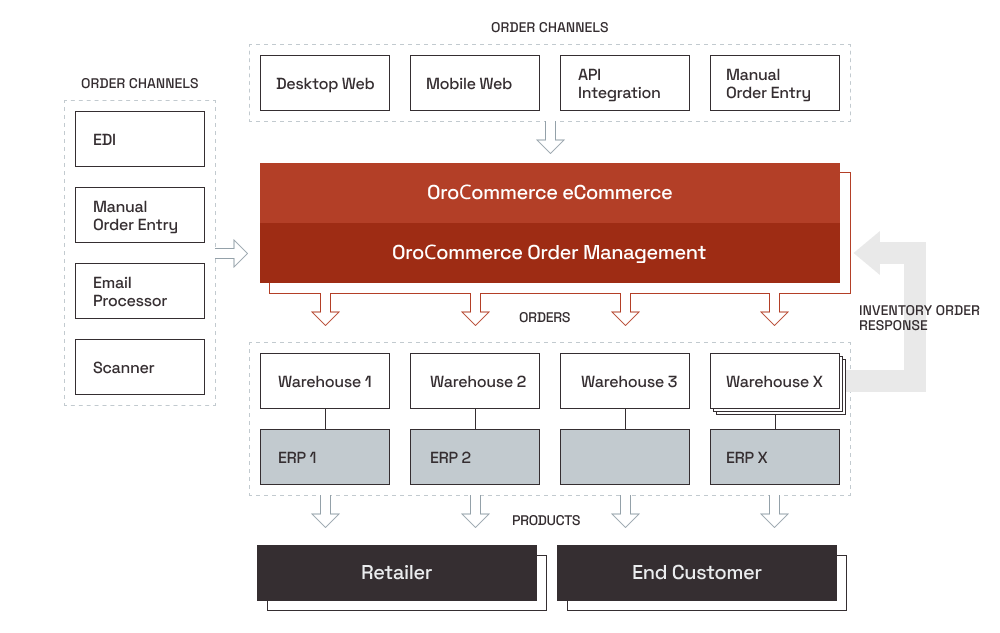
B2B brands like Animal Supply Company use OroCommerce’s headless approach to unify disconnected systems and power advanced digital experiences.
What makes OroCommerce a strong fit for B2B headless eCommerce?
Oro was purpose-built for B2B, offering native features like role-based permissions, corporate account structures, multi-price lists, and robust workflows. These backend capabilities are all exposed via APIs so that you can build custom storefronts or portals on top of a stable B2B engine.
How does Oro support integration-heavy headless environments?
Oro’s strength lies in its integration depth. It acts as a centralized hub that connects with ERPs, CRMs, PIMs, and third-party systems through RESTful APIs and webhooks. With full control over the frontend and backend layers, businesses can digitize and automate even the most complex buying journeys.
Pros:
- Deep B2B functionality natively available via API
- Flexible data model and back-office customization
- Strong support for multi-tenant setups
- Enterprise-grade integration capabilities
Cons:
- Requires development and IT support to fully implement headless
- Backend may be more complex than needed for B2C stores
- Not focused on startup-friendly ease of use
Bonus: Best Headless CMS for eCommerce Integration
Headless CMS platforms give brands the flexibility to create, manage, and distribute content without being tied to their commerce backend. This makes them an essential part of a modern headless eCommerce stack, enabling rich digital experiences across storefronts, apps, and touchpoints.
Below are four top headless CMS options that integrate seamlessly with headless eCommerce platforms—perfect for teams using frameworks like React, Vue, or Next.js.
1. Strapi
Strapi is an open-source, Node.js-based headless CMS with full customization capabilities. Developers love it for its flexibility, while marketers benefit from a user-friendly admin panel. It's ideal for teams that want to self-host or need full control over API structure and content modeling.
Key features:
- Open-source and self-hosted (also offers Cloud)
- REST and GraphQL APIs
- Role-based access control and localization
- Custom content types with relational modeling
- Works seamlessly with Saleor, Shopify Hydrogen, or any JAMstack frontend
2. Contentful
Contentful is a popular enterprise-ready headless CMS built for scale and speed. It provides structured content modeling, powerful API access, and editorial workflows. It integrates smoothly with platforms like Shopify, BigCommerce, and Commercetools to power omnichannel content.
Key features:
- GraphQL and REST APIs
- App framework for custom integrations
- Rich media management and webhooks
- Role-based permissions and localization
- Enterprise-grade support and CDN caching
3. DatoCMS
DatoCMS is a performant and developer-first CMS that focuses on structured content and API speed. It’s great for teams working with modern static site generators like Next.js or Gatsby, especially for international eCommerce sites requiring multi-language content.
Key features:
- GraphQL API optimized for speed
- Built-in image API and CDN
- Localization and multi-language support
- Visual content editing and preview tools
- Plugins for eCommerce integrations
4. Directus
Directus is a headless CMS and data platform built to sit on top of any SQL database. It’s a strong fit for custom-built eCommerce systems that need flexible content plus real-time database connectivity without losing structure or control.
Key features:
- Connects to your existing relational database
- REST and GraphQL APIs auto-generated
- Real-time collaboration and data syncing
- Roles, permissions, and activity logs
- Extensible via hooks, flows, and custom modules
Headless eCommerce Platform: FAQs
What is a headless eCommerce platform?
A headless eCommerce platform separates the frontend (what users see) from the backend (where orders, products, and data live). The two communicate via APIs, allowing developers to build custom storefronts using modern frameworks without being limited by backend templates or themes.
Is headless commerce worth it for small businesses?
In most cases, headless commerce is better suited to mid-sized or enterprise businesses. While small businesses can benefit from flexibility, the setup and development costs may outweigh the advantages unless you have unique design or integration needs that justify the investment.
Is Shopify a headless platform?
Yes, Shopify supports headless architecture through Shopify’s Storefront API and Hydrogen, its React-based frontend framework. This allows developers to create fully custom storefronts while still using Shopify’s backend for checkout, product management, and payments.
How much does headless commerce cost?
Costs vary depending on your platform and stack. Expect higher upfront development costs for frontend builds, ongoing maintenance, and possibly infrastructure or API usage fees. While platforms like Shopify or BigCommerce offer headless capabilities within their plans, fully composable platforms like Commercetools or Elastic Path come with enterprise-level pricing.
What are the drawbacks of headless commerce?
The main drawbacks include higher development complexity, increased time-to-launch, and the need for skilled frontend and backend developers. Non-technical teams may also find it harder to manage day-to-day content or UI changes without additional tools or workflows.
How does headless commerce work?
In headless commerce, the frontend and backend are connected via APIs. The backend handles logic—orders, inventory, user accounts—while the frontend (built with a framework like Next.js or Vue) displays data and interacts with users. This separation improves performance, flexibility, and integration capabilities.
How to migrate to a headless eCommerce platform?
Migration to headless typically involves decoupling your frontend from your backend system. You’ll choose a headless CMS or frontend framework (like Next.js) and connect it to your eCommerce backend (e.g., Shopify, BigCommerce, Magento) via APIs. It's important to audit your current data, define content structures, and test thoroughly before switching live.
Final Words: Is Headless eCommerce the Future of Online Retail?
Headless eCommerce has moved from a developer buzzword to a strategic advantage for brands aiming to stay fast, flexible, and future-ready. By decoupling the frontend from the backend, businesses can deliver richer customer experiences, launch faster, and adapt to new channels with ease.
Still, going headless isn’t a must for every business. It’s a strong fit for teams with technical resources and a need for customization, speed, or omnichannel delivery. For brands that outgrow theme-based systems or want to take full control of their digital experience, headless provides the architecture to scale without limitations. Headless commerce is already reshaping how top brands build—and it’s only accelerating from here.
We hope you found this article insightful and now have a clear understanding of a headless eCommerce platform. For more content like this, be sure to visit the LitExtension blog and join our eCommerce community to gain further insights and connect with fellow business owners.

